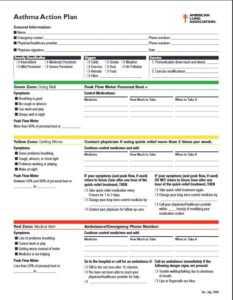 Evidence shows that the development of an active partnership between a patient with asthma, their caregivers and health care providers establishes open communication, and that education in self-management improves outcomes of chronic asthma.
Evidence shows that the development of an active partnership between a patient with asthma, their caregivers and health care providers establishes open communication, and that education in self-management improves outcomes of chronic asthma.
The National Heart, Lung and Blood Institute (NHLBI), as well as the Allergy and Asthma Foundation of America provide guidelines to meet the standard of care. They recommend every person with asthma to have a written Asthma Action Plan. Asthma Action Plans are used to guide self-management.
Asthma Action Plans provide instructions for:
- Daily treatment of asthma—including medication and environmental controls
- What to do for worsening asthma—including when and where to seek care
The highlights of Asthma Action Plans are the following:
1.They have three zones
- Green zone: doing well; breathing is good; no cough or wheeze; sleeping all night
- Yellow zone: getting worse; some breathing problems, cough, wheeze or tight chest; waking at night; interference with work or play
- Red zone: medical alert; problem breathing; cannot work or play; medicine is not helping
2. Self-assessment, through the use of expiratory peak flow monitoring allows individuals to establish a personal best peak flow as the reference value to recognize early symptoms of asthma.
3. They review exposure to allergens, irritants and individual triggers to increase awareness and recognition of causes and effects.
Common triggers include:
- Colds/viruses
- Exercise
- Animal exposure
- Smoke
- Dust
- Weather
- Food
- Air pollution
- Stress/anxiety
4. They clarify if the quality of life is affected in these areas:
- Work or school days missed
- Daily activities
- Quality of sleep
5. They can help identify factors contributing to symptoms, including:
- Poor adherence
- Perception of treatment
- Unrecognized symptoms
- Concerns about asthma and asthma treatment
- Expectations and goals
6. And, they provide education and asthma facts about:
- What defines well-controlled asthma
- Assessing current level of control
- Knowing the roles of medications: maintenance vs. rescue
- The different inhaler techniques
- Self-monitoring
- When and how to handle worsening signs of asthma
- Devising an approach to avoiding allergen
Asthma action plans are typically paper-based. However, smartphone-based plans—i.e. apps– are also available. A 2017 study published in the Annals of Allergy Asthma and Immunology showed that those adolescents with uncontrolled asthma who used an app improved more on their Asthma Control Test questionnaires (the form we distribute to patients during office visits) than those who used a paper-based app. Asthma apps that are available to purchase include these:
- Assist me—inhaler assistance
- Wizdy Pets—a kids educational game
- Asthma Tracker
- AsthmaMD
We live in the era in which the phrase ‘personalized medicine’ has even greater potential because of technology. “One-size-fits-all” does not apply in asthma and other medical conditions. Whatever works to recognize if your asthma is worsening, and to make immediate changes in managing those symptoms, are the ultimate goals. Having and implementing a clear plan gives us confidence in controlling our health.
Yvette, RN, BSN